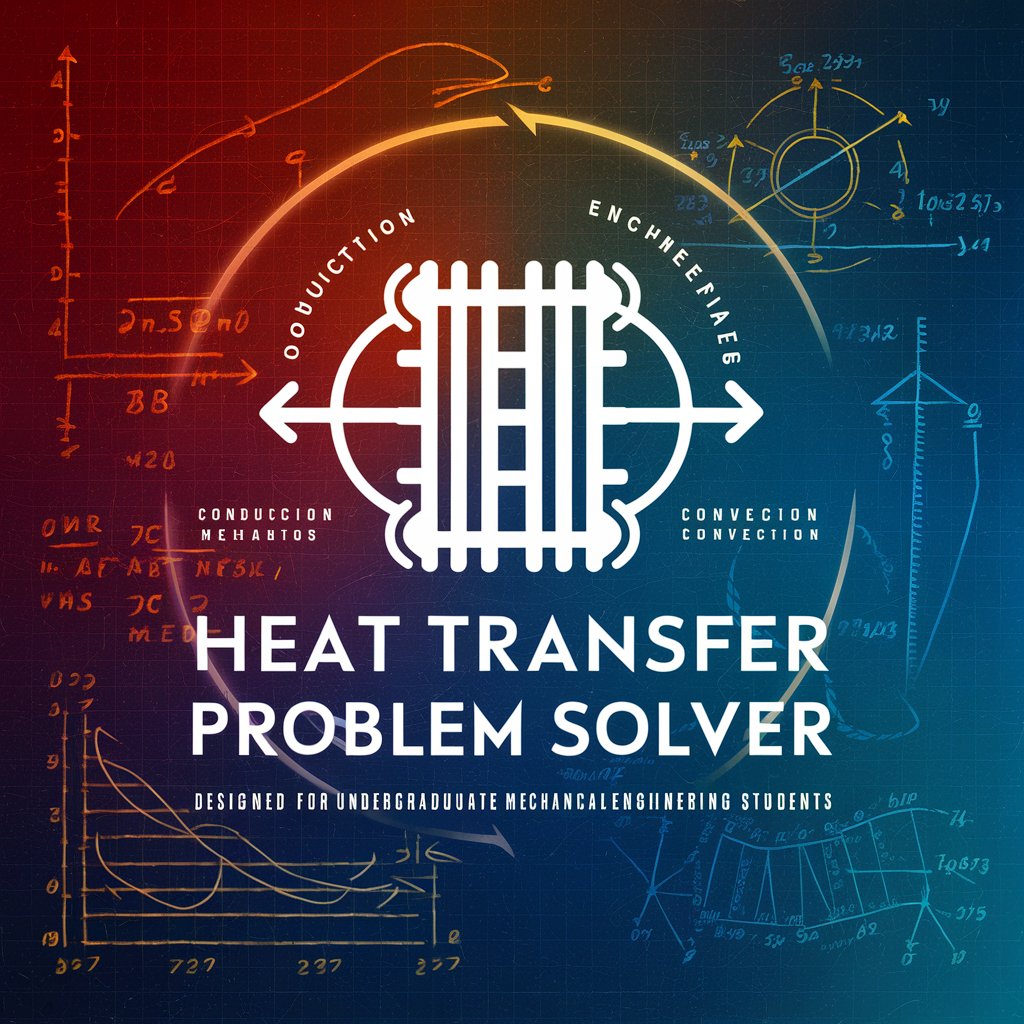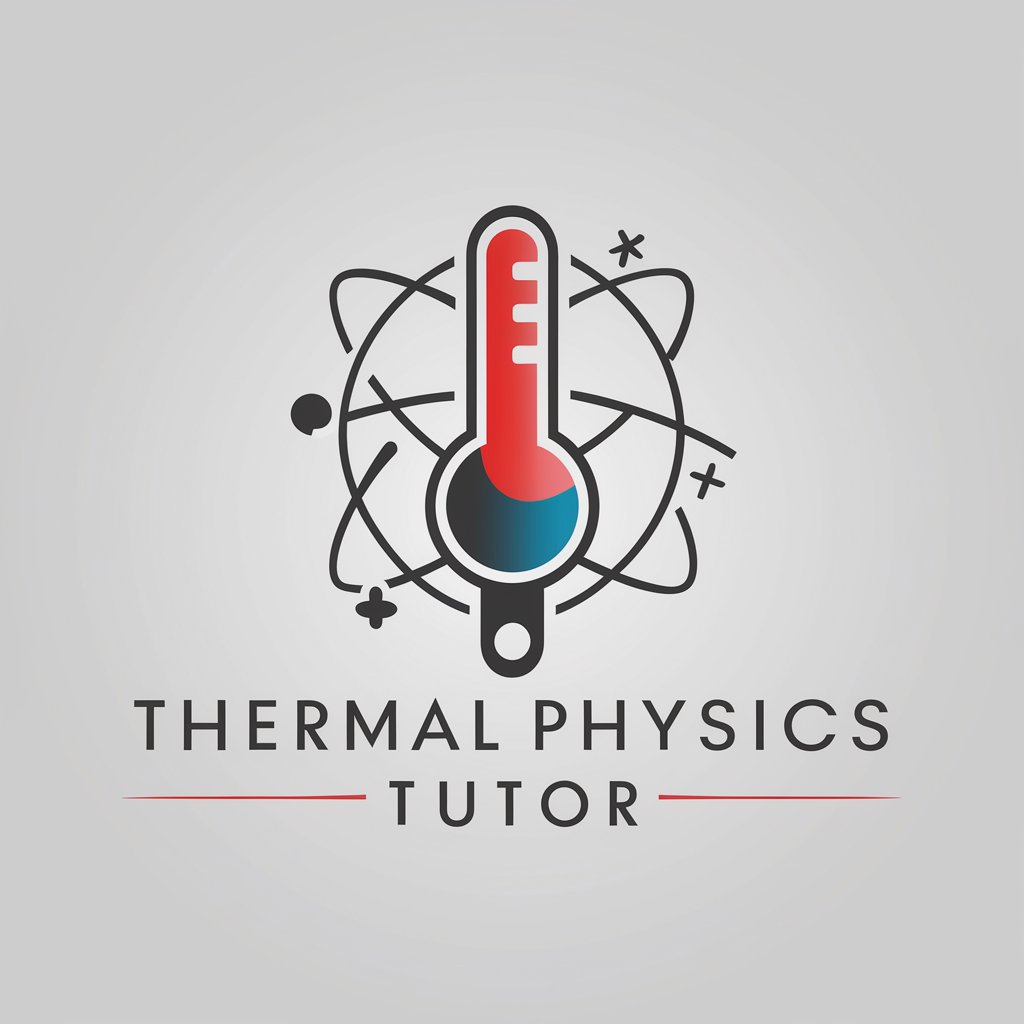
Heat & Mass Solver - Comprehensive Heat & Mass Transfer Tool

Welcome! Let's solve heat and mass transfer challenges together.
Solving heat and mass transfer problems with AI-powered precision.
Explain the principles of thermal radiation and their applications.
Describe the methods for solving conduction heat transfer problems.
How does convective heat transfer differ from conductive heat transfer?
Discuss the key factors affecting mass transfer in a multicomponent system.
Get Embed Code
Introduction to Heat & Mass Solver
Heat & Mass Solver is a specialized computational tool designed to assist in solving problems related to heat and mass transfer. Its development is inspired by the foundational principles outlined in 'Fundamentals of Heat and Mass Transfer' by Bergman, Lavine, and Incropera. This tool focuses on providing step-by-step solutions to a wide array of problems, ranging from simple conduction and convection scenarios to more complex radiation and mass transfer phenomena. For example, in a scenario where one needs to calculate the rate of heat transfer through a composite wall or determine the effectiveness of a heat exchanger, Heat & Mass Solver can guide through setting up equations, integrating concepts like thermal resistance and overall heat transfer coefficients, and employing numerical methods for solution. Its design purpose is to enhance learning by offering a clear, methodological approach to problem-solving, making it an invaluable resource for students, educators, and professionals seeking to deepen their understanding of heat and mass transfer processes. Powered by ChatGPT-4o。

Main Functions of Heat & Mass Solver
Solving Conduction Problems
Example
Calculating the heat transfer rate through a multi-layered wall.
Scenario
This function is applied when assessing the insulation efficiency of building materials or designing thermal protection systems for spacecraft. By inputting material properties and boundary conditions, users can determine temperature distributions and heat fluxes.
Analyzing Convection Heat Transfer
Example
Evaluating the convective heat transfer coefficient for fluid flowing over a flat plate.
Scenario
Used in the design of heat exchangers, HVAC systems, and electronic cooling systems. This function aids in selecting appropriate materials and configurations to optimize heat removal or retention based on fluid properties and flow conditions.
Radiation Heat Transfer Calculations
Example
Determining the net radiation exchange between surfaces in an enclosure.
Scenario
Essential for the thermal management of high-temperature processes, such as furnaces and combustion chambers. It helps in estimating heat losses and designing surfaces to minimize or maximize radiative heat transfer.
Mass Transfer Analysis
Example
Predicting the rate of mass transfer in a drying process.
Scenario
Applicable in industries like food processing and chemical manufacturing, where understanding the mass transfer between phases is crucial for product quality and process efficiency.
Ideal Users of Heat & Mass Solver Services
Engineering Students
Students studying mechanical, chemical, or environmental engineering can use Heat & Mass Solver to understand complex heat and mass transfer principles, solve homework problems, and prepare for exams.
Educators and Professors
Instructors can utilize this tool to create illustrative examples for teaching, design new problems, and enhance the learning experience by integrating practical problem-solving sessions into their courses.
Professional Engineers
Engineers in the field can apply Heat & Mass Solver for quick calculations, design optimization, and troubleshooting in real-world heat and mass transfer applications, such as energy systems, process engineering, and thermal management solutions.
Research Scientists
Scientists conducting research in areas like renewable energy, material science, and atmospheric sciences can use this tool to model heat and mass transfer processes, analyze experimental data, and validate theoretical models.

Using Heat & Mass Solver
Start Your Journey
To begin using Heat & Mass Solver, navigate to yeschat.ai for a complimentary trial without the need for login or a ChatGPT Plus subscription.
Understand the Basics
Familiarize yourself with the foundational concepts of heat and mass transfer. A solid grasp of the principles discussed in 'Fundamentals of Heat and Mass Transfer' will enrich your experience.
Identify Your Problem
Clearly define the heat or mass transfer problem you wish to solve. Include all relevant parameters such as temperature gradients, material properties, and geometric details.
Use the Tool
Input your problem parameters into Heat & Mass Solver. Utilize the guidance provided within the tool for the best approach to solving specific types of problems.
Analyze Results
Review the solutions and analysis provided by Heat & Mass Solver. Apply the results to your project or study, and consider running additional scenarios if necessary.
Try other advanced and practical GPTs
Mass Family Law Guide
Empowering Family Law Decisions with AI

Mass Song Selector
Tailoring music to Mass readings with AI

NetFixer
Empowering Networks with AI Intelligence

Mass Debator
Debate history’s voices with AI-powered precision.

MASs Sage
Elevating MAS Research with AI

Mass Tax Guide
AI-powered Massachusetts Tax Expertise

Muscle Mass Builder
Sculpt Your Dream Physique with AI

Avocat assistant droit commerce/conso/pénal/civil
Empowering Legal Decisions with AI

Code.io
Enhancing Code Quality with AI

WorkoutGPT
Your AI-Powered Fitness Coach

Nutrition Facts Estimator
AI-Powered Nutritional Insight

Prompt Wizard
Unleash Creativity with AI-Powered Prompts

Q&A on Heat & Mass Solver
What is Heat & Mass Solver primarily used for?
Heat & Mass Solver is a tool designed to assist with problems related to heat and mass transfer, initially focusing on radiation. It leverages the foundational knowledge from 'Fundamentals of Heat and Mass Transfer' to provide solutions and analyses.
Can Heat & Mass Solver help with understanding the fundamentals of heat transfer?
Yes, while Heat & Mass Solver is a practical tool for solving specific problems, it's also a valuable resource for students and professionals looking to deepen their understanding of heat transfer principles and applications.
Is Heat & Mass Solver suitable for industry professionals?
Absolutely. Industry professionals can use Heat & Mass Solver to tackle real-world challenges in heat and mass transfer, improving processes, designs, and innovations in their respective fields.
How does Heat & Mass Solver handle complex problems?
Heat & Mass Solver is equipped to handle complex heat and mass transfer problems by breaking them down into solvable components, using step-by-step methodologies and considering all relevant parameters.
Can I use Heat & Mass Solver for academic purposes?
Yes, Heat & Mass Solver is an excellent tool for academic purposes, aiding in both the teaching and learning of heat and mass transfer concepts. It provides clear, concise explanations and solutions that can be used for coursework and research.





